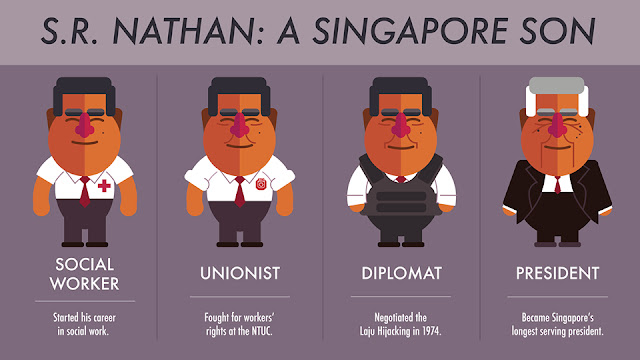The early years
Born in Singapore on July 3, 1924, Mr S R Nathan had a difficult life growing up. He lost his father when he was 8. He was expelled twice from school, first by Anglo Chinese Middle School and then by Victoria School.
PIc: Remembering S R Nathan Facebook page - A portrait of Mr Nathan at around age 18.
At 16, he left home for Muar to look up an old barber and stayed with him while working as a clerk, reuniting with his family four years later during the Japanese Occupation.
When the war ended, Mr Nathan worked as a clerk in the Public Works Department. When he started university at the age of 28, he took no pay leave from work but would still go back during vacations to earn extra pocket money.
Source: Remembering S R Nathan Facebook page
As a Social Worker
After completing his diploma in social studies with distinction at the University of Malaya, he entered the Singapore public service as a medical worker in 1955, and took up a posting with the seafarers union a year later.
As a seamen’s welfare officer, he helped seafarers to resolve their grievances, such as wrongful discharge, unpaid wages or bad treatment. During his stint, the young Mr Nathan built a reputation for being willing to go above and beyond to help the seafarers, and even earned the confidence of employers in the shipping companies that he had to negotiate with.
Read more here: TODAY - S R Nathan, 'who always put country before self', dies
As a Unionist in NTUC
Mr. Nathan was pivotal in reshaping the Labour Movement from that of antagonistic, adversarial unionism to that of rational discussion of mutual interests. The Labour Movement was to have a large role to play in nation building.
Mr. Nathan helped workers in every way possible. From individual assistance, collective bargaining, solving disputes and laying the bricks for tripartite partnership, he was involved every step of the way.
“He understood human beings”, quotes Mr. R.O. Daniel, 77, a retired civil servant who worked with him in the Labour Research Unit. “He had diplomacy inherent in him even from the early days”
Read more here: Five Stars and a Moon - The world of SR Nathan in 1961
As a Diplomat
On 31 January 1974, four men armed with submachine guns and explosives attacked the Shell Oil Refinery on Pulau Bukom Besar, an island south of mainland Singapore. After they failed to blow up the oil tanks, the group – dubbed the “Bukom bombers” by the newspapers – hijacked the ferryboat Laju at the Bukom jetty and held five crew members hostage.
Pic: The New Paper - The
marine police negotiated with a Laju hijacker
After several days of negotiation that involved the governments of Singapore and Japan, the hijackers agreed to release the hostages in exchange for a party of guarantors to ensure their safe passage out of Singapore.
The Singapore guarantors – comprising eight government officials and four Singapore Armed Forces commandos – were led by S. R. Nathan, who was then director of security and intelligence at the Ministry of Defence.
The incident ended on 8 February 1974, when the hijackers left for Kuwait with the Singapore guarantors.
Upon arrival in Kuwait, the Singapore party handed the matter over to the Kuwaiti and Japanese governments and returned to Singapore, arriving the following day on 9 February.
This incident was our young nation’s first encounter with international terrorism. Singapore was then the world’s third-largest oil refining centre, and supplied a substantial amount of oil to countries in the region. There would have been severe and far-reaching economical impact on Singapore had the terrorists succeeded in their objective to destroy the oil refinery at Pulau Bukom.
The Singapore government’s experience in the long, drawn-out negotiations with the terrorists as well as with the Japanese and North Korean governments during the Laju Incident reminded Singapore’s political leadership of the need to have an effective, dedicated force in the event of any terrorist attacks on Singapore. This led to the development of the Special Operations Force (SOF) from the SAF Commandos in 1985. The SOF was deployed in the hijacking of Singapore Airlines Flight SQ117 in 1991 to great effect and the incident was resolved within a few hours, compared to the 9 days it took for the Singapore government to resolve the Laju Incident.
Read more here: NLB's Singapore Infopedia - The Laju Hijacking
Watch the Channel News Asia - Days of Rage: Laju Hijack YouTube video
As Singapore's 6th President
At 75, he became the sixth President of Singapore, and the longest-serving President to date.
With his people-oriented disposition, Mr Nathan actively engaged and interacted with Singaporeans and various groups and communities even when he was well-advanced in years.
Pic: SGAG Facebook page
Most importantly, Mr Nathan had a heart for ordinary people. He was warm, gracious and well-loved by Singaporeans.
Spurred by his deep personal desire to help those who were less fortunate, Mr Nathan founded the President’s Challenge in the year 2000. Aimed at fostering a cohesive and caring Singapore, the Challenge brought Singaporeans from all walks of life together to raise funds and volunteer their time to help the less fortunate.
This legacy of his compassionate vision still burns strong within the Public Service. Every year, I am heartened to see our public officers and agencies actively contributing their time and energy towards helping our society’s less privileged members through the President’s Challenge. Mr Nathan’s admirable qualities have earned him a place in our hearts and minds.
Excerpts from tribute by Peter Ong, Head of Civil Service. Read the entire tribute here
Learn more about the life of Mr S R Nathan here: http://bit.ly/2bOFErR





No comments:
Post a Comment